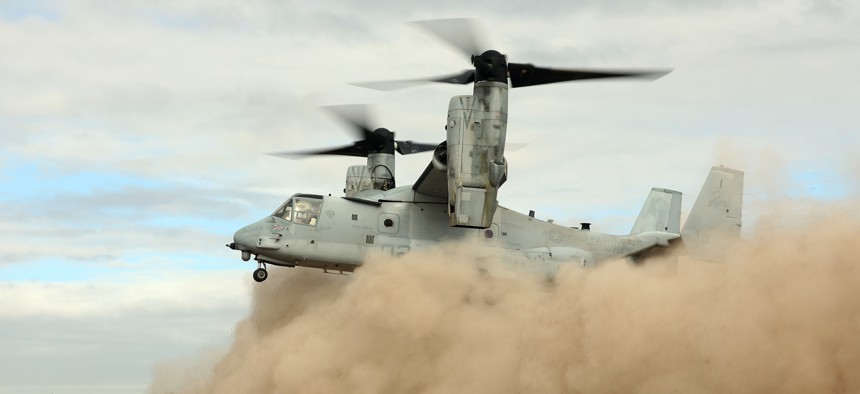
U.S. Marine Corps pilots land a MV-22 Osprey into the exercise theater to familiarize Australian leaders with the Osprey platform June 21 during Exercise Hamel in Shoalwater Bay Training Area, Australia. U.S. Marine Corps / Staff Sgt. Keith Anderson
More Than Just Subs: AUKUS Will Change Pacific Air Ops as Well
For example, U.S. air forces will be able to practice and refine the burgeoning agile combat employment, or ACE, concept.
The Biden administration’s moves to strengthen diplomatic and military ties to Australia by—among other actions—sharing U.K. and U.S. nuclear-powered submarine technology through the creation of the AUKUS defense partnership, has garnered significant attention among national security scholars and practitioners. Although the trilateral submarine agreement understandably attracted the majority of interest, several of the tactical, bilateral aspects of the partnership between the United States and Australia could have important implications, particularly in the air domain. Through cooperative, diplomatic actions, the U.S. will likely enhance its capability to compete strategically in the Indo-Pacific.
On September 16, U.S. Secretary of Defense Lloyd Austin outlined AUKUS-associated initiatives “to co-develop advanced defense capabilities” with Australia. Australian Defense Minister Peter Dutton amplified the strategic intent of the AUKUS agreement by foreshadowing efforts aimed at “enhancing our force posture cooperation, increasing interoperability, and deepening alliance activities in the Indo-Pacific.” These deepening alliance activities will include “rotational deployments of all types of U.S. military aircraft to Australia.” The Commander of the United States Pacific Air Forces also recently affirmed that strategic intent as he described a willingness to send all available U.S. aircraft in the region, including fifth-generation F-35 Joint Strike Fighters, to Australia as an element of these expanded rotations. These aircraft deployments will supplement the existing Marine Rotational Force Darwin, which is a contingent of 2,500 U.S. Marines on annual, six-month deployments to Australia.
Consistent, rotational deployments of all models and variants of U.S. aircraft to Australia are likely to enhance the U.S. position in Indo-Pacific strategic competition in three ways. The first and perhaps most significant potential effect of the agreement is to enable U.S. air forces to practice and refine the burgeoning agile combat employment, or ACE, concept. ACE is a concept designed to confound an adversary’s targeting processes by using multiple airfields in one region to disperse air forces and project combat power from many locations. These potential airfields range from robust international airports to austere airstrips. By pursuing a dispersion of force capability, the U.S. is tacitly acknowledging that the concept of a fixed, centralized air hub of operations used in the post 9/11 conflicts of the last two decades—for example, at Ramstein Air Base, Germany; Al Udeid Air Base, Qatar; and Bagram Air Base, Afghanistan—is probably less effective against current U.S threats.
The ACE concept, which originated five years ago to counter technological advances by near-peer powers like China, relies on networks of willing partner states that welcome coalition training within their borders. Despite Australia’s considerable air distance from China, Australia offers an array of alternatives from which future ACE operations could be launched against China. Moreover, ACE locations in Australia would provide additional options for logistical resupply that are more distant, and thereby less susceptible to attack, than current options in Japan, Korea, and Guam. In short, as Derek Solen has concluded, “the more countries that host … dispersed units, the greater the dilemma that Beijing will face.”
A second potential impact of the AUKUS-related U.S. aircraft deployments to Australia is improved interoperability between the two militaries. As learned through North Atlantic Treaty Organization (NATO) experiences, including conflicts from Libya to Afghanistan, coalition military operations present complex challenges; impediments to effectiveness persist in spite of NATO’s vigorous coalition training. By codifying recurring aircraft and associated personnel deployments to Australia, the two countries have established a framework for mitigating interoperability challenges through exercises and exchanges of tactics and procedures. Furthermore, because the inventory of the Royal Australian Air Force (RAAF) includes so many aircraft also operated by the United States, maintenance and logistical support of these aircraft will benefit from economies of scale. Interoperability also will serve as a force multiplier for RAAF assets, which are now are largely reliant on U.S. aerial refueling capability to extend their reach.
A third potentially noteworthy benefit to U.S. air domain capabilities from the AUKUS agreement is expanded access, basing, and overflight, or ABO, permissions in the region. ABO permissions are a standard assumption of contingency planning; however, as the United States experienced in 2003 when it was forced to amend plans for a northern assault into Iraq from Turkey, ABO permissions are never guaranteed. By making a “definitive strategic choice” through ratification of the AUKUS partnership, however, Australia has effectively chosen sides in the escalating competition with China. This decision makes U.S. ABO permissions in Australia a reasonable assumption going forward and potentially serves as a deterrent to Beijing’s behavior in the region.
One should not underestimate the importance of the agreement to share U.S. and British nuclear-powered submarine technology through the creation of the AUKUS partnership. This technology may eventually create a uniquely-capable maritime ally in the Indo-Pacific. One would also be equally prudent to recognize the deeper and more immediate connections that the AUKUS partnership will facilitate, particularly in the air domain. Collectively, these key elements of the trilateral security agreement represent a major step forward in Washington’s efforts to assure integrated deterrence in order to prevail in the era of strategic competition.
DISCLAIMER: Opinions, conclusions, and recommendations expressed or implied within are solely those of the author and do not necessarily represent the views of the Air University, the United States Air Force, the Department of Defense, or any other U.S. government agency.
Col. Douglas D. Jackson of the U.S. Air Force is a military fellow at CFR.
This piece, first published by the Council on Foreign Relations, is used with permission.
NEXT STORY: What’s Next for the Quad?



